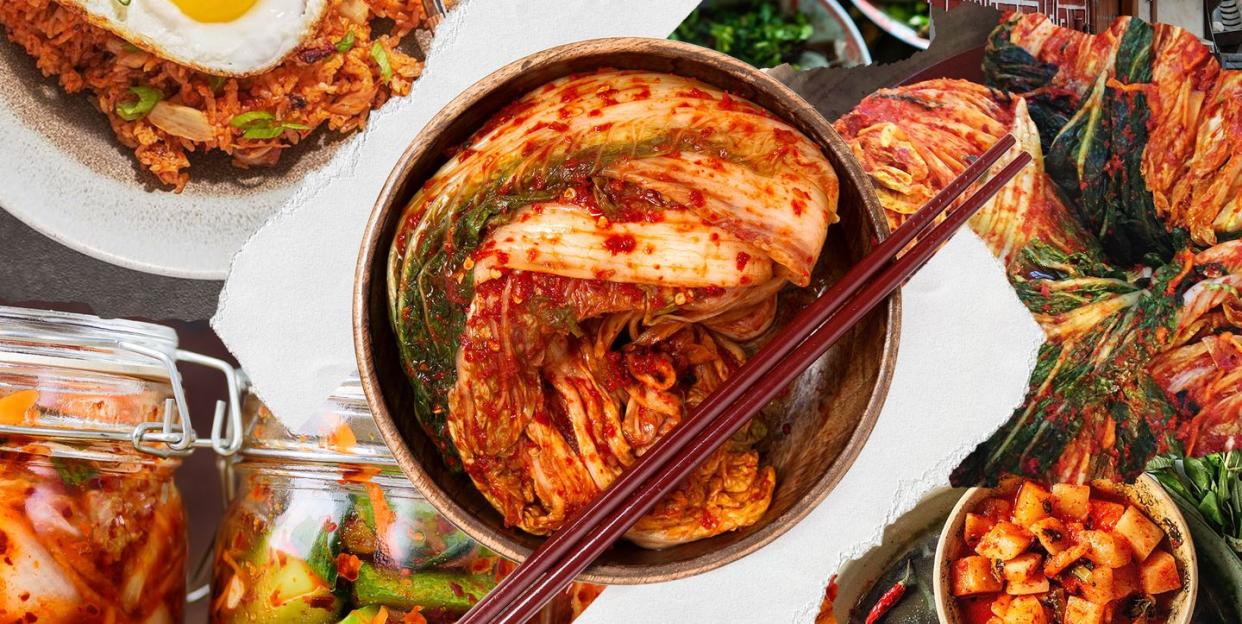Yes, Kimchi Is Alive—Here's Everything To Know About The Ingredient

A pretty sizable portion of my favorite things are fermented. Sauerkraut on a Hebrew National hot dog, soul-warming miso soup, and that ice cold beer at the end of a long day are all things made possible by that holiest of metabolic processes. And in my mind, there’s no other food that deserves the fermented crown more than kimchi.
In the states, people tend to think of kimchi solely as the Korean pickled cabbage that has grown exponentially in popularity over the past couple of decades. However, kimchi is much much more than that. To get a full rundown of all things kimchi I spoke to Hyunjoo Albrecht, the founder and head chef behind Sinto Gourmet, the makers of one of our favorite brands of store-bought kimchi.
So what is kimchi?
Kimchi should be thought of more as a method than a singular dish. Hyunjoo describes it succinctly as “a very traditional, fermented vegetable originating in Korea that is fermented with salt as well as other seasonings.” She also told me that it’s the way Korean people have been preserving vegetables for centuries. Traditionally, the salted veg would be placed in earthenware pots and buried to keep cool during summer months and to keep from freezing in the winter. Today kimchi is kept in the fridge. (When kept at room temperature, the fermentation can occur too quickly and it will spoil.)
Hold on—is kimchi...alive?
Yes! Whether you make it at home or buy it from the store, kimchi is usually unpasteurized. This means that as long as you don’t eat it, the microorganisms and naturally occurring yeast in your kimchi can continue to ferment while it sits in your fridge. As a result, a batch made or bought a week ago will taste very different than a batch that’s been in your fridge for 3 months.
Are there different types of kimchi?
“According to the experts at the Kimchi Museum in South Korea” Hyunjoo told me, “there are over 300 types of kimchi.” Talk about range! The version that most folks are familiar with is pogi kimchi, which is made with napa cabbage. But it is also often made with radish, cucumber, chives, and even perilla leaves.
What does kimchi taste like?
This is kind of hard to answer, because as Hyunjoo pointed out, there are so many different types of kimchi, most of which have their own unique taste. However the some classic ingredients used to flavor kimchi are salt, garlic, ginger, and gochugaru—a Korean dried chili powder that gives pogi kimchi its distinctive red color and iconic spiciness.
Hyunjoo also says that depending on where you are in Korea, you may see people use fish sauce, saeujeot (fermented shrimp), or even fresh seafood that would ferment along with the cabbage, providing a ton of umami.
The common flavor that can be found across all kimchi is the sour-saltiness that comes from the fermentation. Depending on how long the kimchi has aged, this funk will be more or less pronounced. Some people like crispy, fresh tasting kimchi and others, like myself, prefer the unique and complex flavors that can come from more mature kimchi.
Is kimchi always spicy?
When I asked her this question Hyunjoo joked, “You know how there are 50 shades of gray? There are 50 shades of spiciness in Korean kimchi.” Each individual chef, manufacturer, and home cook determines how much gochugaru and other spicy ingredients to put in their kimchi. The more chili powder the spicier it gets, and vice versa. In fact, there is something called baek (or white) kimchi which is kimchi fermented with absolutely no chili powder whatsoever.
Can I cook with kimchi?
Though kimchi is perfectly delicious in its raw state, it can also provide an amazing spice and ferment-y kick to a number of dishes. The two most iconic dishes are kimchi fried rice (pretty self-explanatory) and kimchi jjigae, which is a stew made with kimchi and various other veggies and ingredients like pork belly, seafood, and green onions. I’ve also seen kimchi in nachos, burritos, and Bloody Marys.
Hyunjoo noted that she likes to cook with kimchi that has been fermenting for a bit longer because the the pickle-y and funky flavors will be more pronounced and add more to the dish.
How do I buy kimchi?
At one point it would have been difficult to find kimchi outside of Korean or Asian markets, but now brands like Sinto can often be found in many supermarkets and big box stores.
How do I store kimchi?
Kimchi should always be stored in the fridge, even if it hasn't been opened. As mentioned above, it's not pasteurized and will ferment too quickly at room temperature. Sinto Gourmet recommends you eat your kimchi within 6 months of the manufacturing date.
However Hyunjoo also told me that, “in Korea, homemade kimchi and restaurant-made kimchi is kept longer than 6 months. More like one year or two years, no problem. Some restaurants even promote that their kimchi is more than three years old.” We don’t necessarily recommend you experiment with aging kimchi for years, but if your kimchi is a bit older than 6 months, it’s probably safe to be eaten.
One more storage tip from Hyunjoo: Submerge the fermented veggies under the pickling liquid. “The kimchi liquid will block the air from the kimchi and the kimchi stays crunchier and fresher over time.”
You Might Also Like

